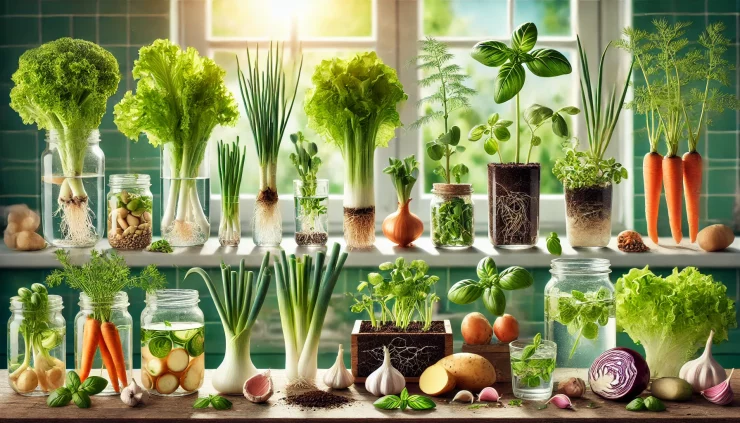Have you ever wondered if you can stretch your grocery budget by regrowing vegetables at home? The good news is, you can! Many vegetables can be regrown from scraps or remnants, making it a fun and sustainable way to enjoy fresh produce. Here are ten veggies you can regrow from the grocery store:

Green Onions
Green onions, or scallions, are one of the easiest vegetables to regrow. Simply place the white roots in a glass of water, ensuring the roots are submerged while keeping the tops above water. Place the glass on a sunny windowsill and change the water every few days. In a week or so, you’ll notice new green growth sprouting from the tops.
Lettuce
Regrowing lettuce is straightforward. Save the base of the lettuce head and place it in a shallow dish of water. Keep it in a sunny spot and change the water every couple of days. New leaves will begin to emerge from the center, and within two weeks, you can harvest fresh lettuce.
Celery
Celery can also be regrown from its base. Cut about two inches from the bottom of the celery stalk and place it in a dish with a bit of water. Leave it in a sunny location and change the water every few days. After a week, new stalks and leaves will start to grow. Once the growth is significant, you can transplant it into soil.
Carrots
While you can’t regrow an entire carrot from its top, you can regrow carrot greens. Place the top of a carrot in a shallow dish of water, cut side down. Within a few days, you’ll see green shoots emerging. Carrot greens are edible and can be used in salads, pesto, or as garnishes.
Garlic
Garlic is incredibly easy to regrow. Plant a single garlic clove (pointy end up) in the soil and water it regularly. In a few months, you’ll have a new garlic bulb. For quicker results, you can grow garlic greens by placing cloves in a small glass of water. The greens can be harvested and used like chives.
Ginger
Ginger is another great vegetable to regrow. Plant a small piece of ginger root with the buds facing up in a pot of soil. Place it in indirect sunlight and water it lightly. New shoots will begin to emerge in a few weeks. After a few months, you can harvest fresh ginger by digging up the plant.
Basil
You can regrow basil from cuttings. Place a basil stem with a few leaves in a glass of water, ensuring that at least two inches of the stem is submerged. Place the glass in a sunny spot and change the water every few days. Roots will begin to form within a week, and once they are an inch long, you can transplant the basil into soil.
Potatoes
Potatoes are easy to regrow from scraps. Cut a potato into pieces, making sure each piece has at least one eye. Allow the pieces to dry out for a couple of days, then plant them in soil about four inches deep. Water regularly, and in a few months, you’ll have new potatoes ready for harvest.

Romaine Lettuce
Similar to other lettuces, romaine lettuce can be regrown from its base. Place the base in a shallow dish of water, ensuring the bottom is submerged. Keep it in a sunny spot and change the water every few days. New leaves will begin to grow from the center, and you can harvest fresh romaine lettuce in a couple of weeks.
Sweet Potatoes
Sweet potatoes can be regrown from slips. Cut a sweet potato in half and suspend it with toothpicks in a glass of water, with half of the potato submerged. Place it in a sunny spot and change the water regularly. Shoots will start to grow from the top. Once the shoots are about five inches long, twist them off and place them in water to root. After roots form, you can plant the slips in soil.
Regrowing vegetables from grocery store scraps is a rewarding and eco-friendly practice. Not only does it save money, but it also provides a continuous supply of fresh produce. With a little patience and care, you can enjoy a thriving indoor or outdoor garden. Happy gardening!
News
Jimmy Butler saga takes another twist with superstar’s surprising announcement
The Jimmy Butler trade saga could be over. Or the drama might be in its second-act lull. Who really knows for sure? On Friday, the star forward released a simple, two-word statement through his agent, Bernie Lee, announcing his return to the Miami…
NBA’s Top 10 Plays of the Night | January 17, 2025
The NBA’s Top 10 Plays of the Night for January 17, 2025, showcased an array of jaw-dropping moments that left fans in awe and highlighted the incredible talent across the league. From thunderous dunks to clutch three-pointers, the night was…
2025 NBA Rivals Week
The NBA’s 2025 Rivals Week is set to be one of the most exciting and highly anticipated events of the season, bringing together some of the league’s most storied rivalries for a week of intense competition and unforgettable moments. As…
Anthony Edwards TAKES OVER In New York – 36 Points!
Anthony Edwards put on a show in New York, scoring a game-high 36 points in a performance that showcased his growing potential as a star in the NBA. The Minnesota Timberwolves’ young guard took over the game against the New…
Giannis Antetokounmpo’s 35-PT DOUBLE-DOUBLE vs Raptors!
Giannis Antetokounmpo delivered a dominant performance against the Toronto Raptors, scoring 35 points and grabbing 12 rebounds for a double-double in a game that showcased his MVP-caliber play. The Milwaukee Bucks’ star forward was unstoppable on both ends of the…
Jamal Murray (30 PTS) & Nikola Jokić (TRIPLE-DOUBLE) vs Heat
Jamal Murray and Nikola Jokić put on a masterclass performance against the Miami Heat, with Murray scoring 30 points and Jokić recording a triple-double in a game that showcased the Denver Nuggets’ dynamic duo. The matchup was a testament to…
End of content
No more pages to load











